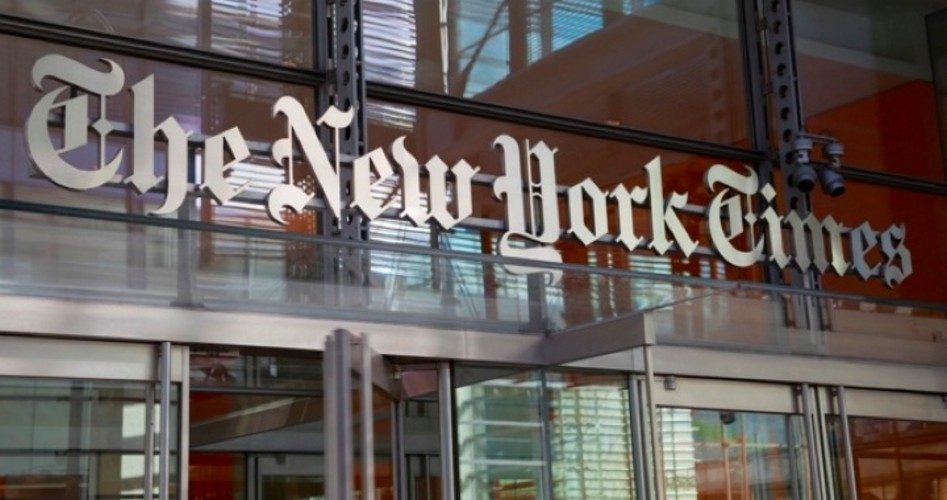
In its press release issued Thursday the New York Times did its best to put lipstick on its pig, noting declines in earnings per share over the last quarter and the last 12 months but claiming that this represented great progress and heralded an improving outlook for the future. Mark Thompson, the Times’ new president, exclaimed that “2013 was a busy year for the Company,” adding,
We launched a new strategy, reorganized the Company, reenergized our advertising department under new leadership, rebranded out international newspaper as the International New York Times and sold the New England Media Group.
In 2014 we will build on those efforts with new digital consumer product launches beginning in the spring, new digital advertising products and a continued focus on international growth.
Call it lipstick, or whistling past the graveyard, Thompson is Titanic’s captain, throwing overboard anything that weighs down the ship and hoping to make port before it sinks out of sight. Fourth quarter revenues fell by more than five percent compared to a year earlier, while advertising revenues dropped more than six percent. For the year, total revenue declined by 1.1 percent while net income fell by more than half. This was the 13th straight quarterly decline in revenues for the emaciated Gray Lady.
In a peculiar accounting twist, the numbers were actually worse than they appeared due to the sale last summer of the Boston Globe and related properties. It appears that the Times’ accountants had all but written off that billion-dollar purchase and when it was sold to Fenway Park owner John Henry for $63 million, the sale had to be booked as a profit.
The timing of its decision to buy the assets of the New England Media Group (NEMG) which included the Boston Globe and other related assets in 1993 for $1.1 billion couldn’t have been worse. In a board room decision to try to expand the Times’ influence up along the eastern seaboard, the investment was made one year before the unofficial beginning of the Internet revolution in 1994, and despite heroic efforts, NEMG never came close to realizing its potential. Six years later the Times’ board compounded its error by spending another $295 million to buy the Worcester (Massachusetts) Telegram & Gazette which became part of the package the Times offloaded onto Henry, taking a 95-percent shellacking in the process. This doesn’t count the pension liabilities the Times was forced to keep as part of the deal.
In addition the Times found a buyer in 2007 for its Broadcast Media Group consisting of 10 radio and television stations for $575 million.
Over the past few years the Times continued to toss its useless but weighty furniture overboard, selling 16 of its regional newspapers in 2012 along with its interests in About.com for $300 million, taking another $100-million loss on that deal.
Its financial statement for 2013 is a catastrophe, with losses all up and down its revenue page: net income, -63.2 percent; income from continuing operations, -67.2 percent; diluted earnings per share, -64.3 percent. And yet, in his opening remarks for its investors’ conference call on Thursday, Thompson was positively rhapsodic:
2013 is my first full year at the company, and we finish on a high note, posting solid results in the fourth quarter. As you’ll hear, there’s some complexity in comparing the quarter with the same period in 2012 because of the special items and the fact that Q4 2012 had an extra week. Nonetheless, we were pleased with the fundamentals of our business in the period.
We slightly increased our overall revenues, excluding that extra week in 2012. We saw favorable trends in both print and digital advertising and added more net new digital subscribers than in the previous 2 quarters. We turned costs, notwithstanding significant investment in our growth initiatives.
He managed to spin the continuing decline in print and digital advertising revenues into a positive:
Print advertising revenue showed steady improvement in the second half of the year, declining less than 2 percent in the fourth quarter, in line with third quarter levels, while digital trends also showed progress in the quarter and ended up roughly flat….
Our advertising performance maintained the momentum it began in the third quarter, as overall advertising revenues declined 1%. Advertising revenues ended the year on significantly better footing than they began it, declining an average of 2% in the second half of 2013.
In the quarter, digital advertising revenue was roughly flat, which represents an improvement on the pattern we’ve seen in recent quarters and a step in the right direction.
The ship continues sinking, he said, but at least his Titanic isn’t sinking quite as rapidly as before. And land is in sight:
At quarter-end, paid digital subscriptions across the company was approximately 760,000, an increase of 19% year-on-year. We added 33,000 net new digital subscribers in the quarter, which is more than we added in each of the previous 2 quarters and positions us well to 2014.
This is called “cannibalization” as he tries to convert past print subscribers to the company’s slick new website with its paywall blocking all but occasional users. Before turning control of the call over to his ad and financial people to handle the questions from investors, Thompson finished with a flourish:
So, to conclude, the tangible progress we made on a number of fronts in 2013 is encouraging. We posted improved results in the year while moving forward with our strategic plan. We remain in the early stages of the transformation of The New York Times Company, and 2014 will be a year in which we have a lot to deliver.
Before then, they have a lot of explaining to do. Just how well is the “cannibalizing” of existing customers going? Denise Warren, executive vice president, spun the response in such a way as to make her boss proud:
I think the question you’re asking … is what’s the potential for cannibalization as we introduce lower pricing tiers? And I think it’s really important for me to underscore something we’ve said in the past, which is that we strongly believe that the cannibalization effect will be mitigated by the fact that the vast majority of our core customers prefer complete access to Times journalism.
So in our view, that really does provide an effective fence around the trade-down. And we believe that we’re going to be able to manage it accordingly.
In parsing Warren’s answer, one gets the feeling that she really is banking on hope that Thompson’s sinking ship gets into port before it runs aground. It’s a “belief system” that somehow Times’ customers will be so loyal that they’re willing to trade print for digital with no loss in revenues to the company.
And then there’s the issue of pension liabilities. After adding in those kept when the Boston Globe was heaved overboard, the Times’ unfunded liabilities totaled more than $350 million. But a close look at the current financials show today’s liabilities of just $80 million. How did that happen? Surely the Times didn’t cut a check for $270 million last year out of their checking account or someone would have noticed. No one on the conference call sought clarity, but the Times’ Chief Financial Officer James Follo shed a little light on the matter. In his own monologue following Thompson, Follo said:
Service costs from pension retiree medical benefits will continue to be included [on the financial statement], but the other pension components, including interest [earned], expected return on assets, [emphasis added] … will be excluded.
There’s only one other way those liabilities could have shrunk by 77 percent in just one year, and that’s by adjusting the expected or anticipated rate of return on those assets. All it would take would be for a slight increase in actuarial assumptions for expected earnings in the future to reduce so dramatically the Times’ future liabilities.
Follo added later in the call: “The pension issue has clearly gotten significantly better, and we feel pretty good about where that’s gone.”
Finally, the Times is facing the maturity of between $200 million and $250 million of its corporate indebtedness, perhaps reflecting the desire of one Mr. Carlos Slim to see the return of some of the $250 million he loaned the company back in 2009 to help it stay solvent or, to keep the analogy going, keep the ship afloat. This may just be where some of the cash received from the sale of those failed ventures noted earlier might be going. Said Follo, in language only an accountant could love:
I think I would add is [sic] we’re coming off in about 12 months of maturity of somewhere in the neighborhood of $200 million, $225 million of bonds that come due.
And obviously, the plan right now is to take some of that cash off the balance sheet and retire that debt.
Consistent with what Mark [Thompson] said, we do think we need to rightsize the debt to the business as it exists today post the divestitures that we’ve gone through the last couple of years.
The Times just might make it to shore if Doug Mataconis is right. In the Outside the Beltway blog, Mataconis opined:
Newspapers like the Times and the Globe are unlikely to fade away anytime soon. They’ve both got national reputations that ensure that they’ll survive in some form, most likely online, for some time to come.
It’s clear, though, that this business model isn’t going to provide the same kind of revenue that the good old days of print used to, especially given the fact that there are countless numbers of news sources available on the Internet, many of which charge nothing for access.
If the Times does make it to port and survive, it will be much smaller, and its voice will be greatly muted as the mouthpiece of the establishment it has served for so many years. As its size continues to shrink, so will its influence.
A graduate of Cornell University and a former investment advisor, Bob is a regular contributor to The New American magazine and blogs frequently at www.LightFromTheRight.com, primarily on economics and politics. He can be reached at [email protected].



